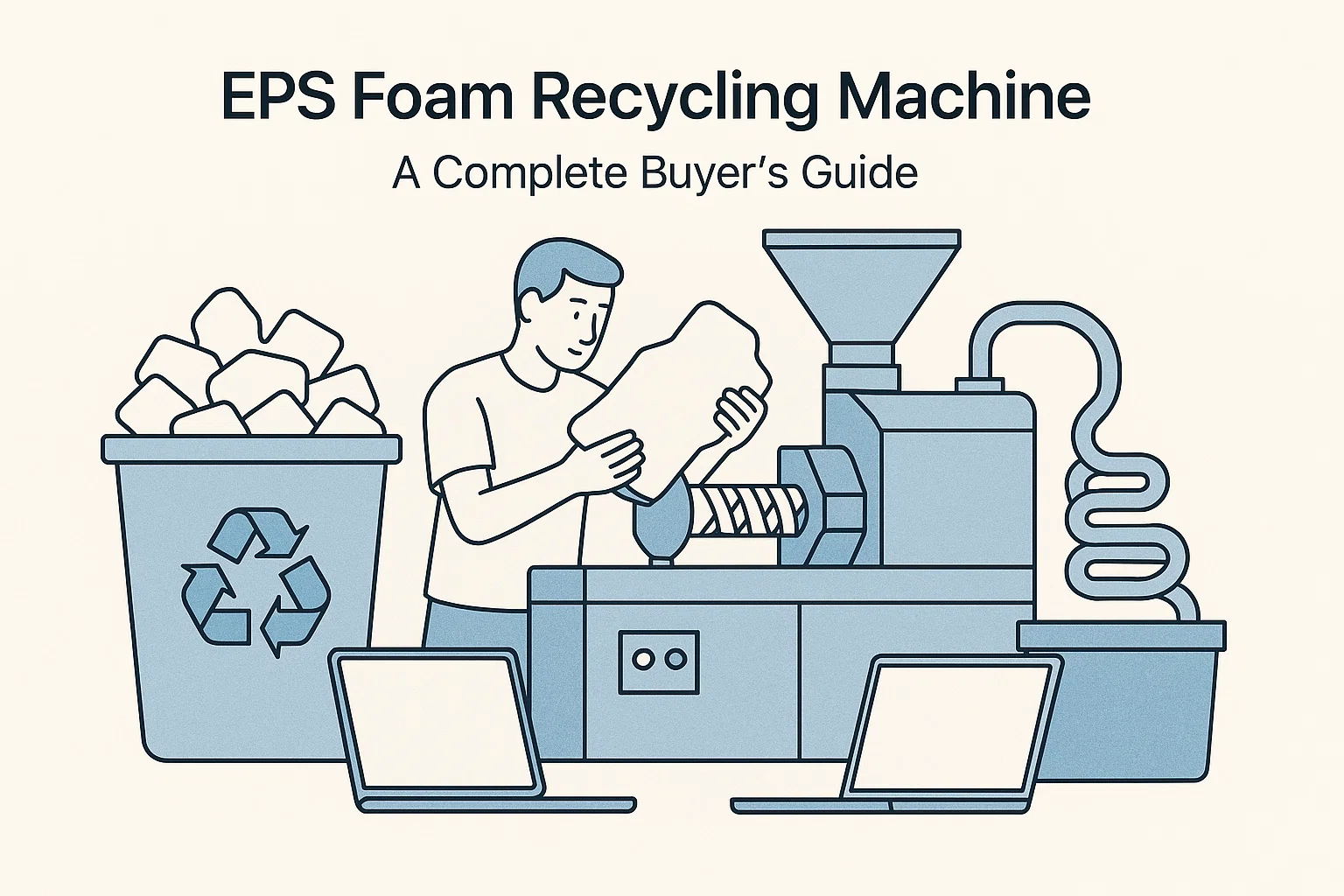A Complete Buyer’s Guide to Choosing an EPS Foam Recycling Machine
Odabir pravog EPS foam recycling machine is a critical business decision for any company handling large volumes of expanded polystyrene (often called Styrofoam). This light but bulky waste not only consumes valuable storage space but also leads to high transportation and landfill costs. The right equipment investment can turn this financial burden into a profitable asset.
However, the market is filled with options and technical specifications that can be confusing. This guide provides a clear framework to help you make an informed choice based on your company’s specific needs. We will explain the different types of machines and detail the key factors you must consider.

Why Your Business Needs an EPS Recycling Machine
Before diving into the technical details, let’s clarify the business case for investing in an EPS recycling machine. This is more than an environmental initiative; it’s a smart financial move.
- Drastically Reduce Costs: Up to 98% of EPS foam’s volume is air. A recycling machine reduces this volume by a ratio of up to 50:1 or even 90:1. This means a sharp drop in waste hauling frequency and transportation fees, along with savings on ever-increasing landfill charges.
- Generate New Revenue: Densified EPS blocks or ingots are valuable commodities used to manufacture products like picture frames, architectural molding, and other plastic goods. There is a stable market demand for this material, allowing you to sell it to recyclers for a consistent revenue stream.
- Enhance Corporate Image & Compliance: Implementing an EPS recycling program demonstrates your company’s commitment to sustainability. This boosts your brand image and helps you comply with increasingly strict environmental regulations.
The Core Decision: Cold Compactor or Hot-Melt Densifier?
This is the first and most important choice you will make. Both machines effectively reduce EPS volume, but their operating principles, output, and ideal use cases are very different.
EPS Cold Compactor
How it works: A compactor uses powerful physical force, typically via screw-driven technology, to compress EPS foam into dense, solid blocks. The entire process involves no heat, resulting in lower energy consumption.
- Prednosti: Low energy use, safer operation (no fumes), and fast startup/shutdown.
- Protiv: The compression ratio is generally lower than a densifier (around 50:1), meaning the resulting blocks are slightly larger for the same weight.
EPS Hot-Melt Densifier
How it works: A densifier first shreds the EPS foam, then uses heat to melt it into a paste-like state. It is then extruded and cooled into highly dense ingots.
- Prednosti: Extremely high compression ratio (up to 90:1), producing very dense, compact ingots that maximize savings on shipping and storage.
- Protiv: Requires a pre-heating period, consumes more energy, and must be operated in a well-ventilated area to manage fumes from the melting process.
Explore Our EPS Recycling Machines
Ready to turn your EPS waste into a valuable asset? Discover Energycle Machine’s range of high-performance compactors and densifiers designed for efficiency and reliability.
View Machine Specs7 Key Factors to Evaluate When Choosing a Machine
Once you have a general idea of the machine type you need, it’s time to dive into the details to see if a specific model fits your requirements. Carefully consider these seven factors.
1. Assess Your EPS Waste Volume and Type
This is the starting point for your decision. You need an accurate picture of how much EPS waste you generate daily or weekly. Is it clean, dry foam from packaging, or is it wet and contaminated, like fish boxes?
- Practical Tip: Conduct a one-week “waste audit.” Collect, weigh, and measure the volume of all your EPS scrap. This will give you the baseline data needed to select the right machine capacity.
2. Calculate Required Throughput (Capacity)
Machine capacity is measured in kilograms per hour (kg/hr) or pounds per hour (lbs/hr). Choose a throughput that is slightly higher than your peak waste generation to ensure smooth operations.
- Primjer izračuna: If you generate 200 kg of EPS waste per 8-hour day, you need a machine with a capacity of at least 25 kg/hr (200 kg / 8 hr). To account for growth, selecting a 40-50 kg/hr model is a safer bet.
3. Compare Compression Ratios
The compression ratio directly impacts your storage and logistics efficiency. A 50:1 ratio means 50 cubic meters of loose foam will be compressed into a 1-cubic-meter block.
- Key Point: Don’t just look at the numbers. Ask for samples of compressed blocks from the supplier to see the density and quality for yourself. A densifier’s 90:1 ratio offers a significant advantage for long-distance shipping.
4. Consider Your Operational Space and Layout
An EPS recycling machine requires a dedicated footprint, including space for the machine itself, a staging area for loose foam, a storage area for finished blocks, and a safe zone for the operator.
- Action Step: Measure the dimensions of the area where you plan to install the equipment. Get the machine’s footprint diagram from the supplier and ensure you have enough room for electrical connections, material flow, and routine maintenance.
5. Check Power and Safety Requirements
Different models have different power requirements (e.g., voltage, three-phase power). Densifiers typically draw more power due to their heating elements and must be installed in well-ventilated areas.
- Safety Tip: Ensure the machine is equipped with standard safety features like emergency stop buttons, overload protection, and safety guards. Confirm with your facility manager that your electrical system can handle the load.
6. Budget and Analyze Return on Investment (ROI)
An EPS recycling machine can range from twenty thousand to over one hundred thousand dollars, depending on its type, capacity, and level of automation. But this is an investment, not just an expense.
- How to Calculate ROI:
- Calculate Annual Savings: (Monthly Hauling Fees + Monthly Landfill Fees) x 12
- Calculate Annual Revenue: (Annual Weight of Recycled EPS x Market Price per kg/lb)
- Annual ROI = (Annual Savings + Annual Revenue) / Total Investment Cost
7. Verify Manufacturer Support and Warranty
Industrial equipment requires long-term service and support. It is crucial to understand the manufacturer’s service network, spare parts availability, and technical support response time.
- Checklist of Questions:
- What is the warranty period and what does it cover?
- Do you provide on-site installation and operator training?
- What is the support process if the machine has an issue?
- Quanto custam e quais são os prazos de entrega para peças de desgaste como lâminas e parafusos?
Processo de Compra em 4 Passos
Com esse conhecimento, você pode agora seguir um processo sistemático, de quatro passos, para completar sua compra.
Passo 1: Auditoria de Resíduos Internos
Quantifique seus resíduos EPS de maneira precisa. Documente sua origem, volume, peso e limpeza. Esses são os dados mais importantes que você compartilhará com os fornecedores.
Passo 2: Triagem Inicial e Contato
Com base no volume de resíduos e nas condições do local, decida se um compactador ou densificador é a melhor opção. Contate alguns fornecedores reputáveis com seus dados de auditoria para recomendações e cotações iniciais.
Passo 3: Teste de Amostra e Due Diligence
Envie amostras de seus resíduos EPS para seus fornecedores em lista curta para teste. Se possível, peça para ver um vídeo da máquina em ação ou visite um site de cliente existente. Ver é acreditar.
Passo 4: Decisão Final e Contrato
Compare o desempenho do equipamento, preço, ROI e serviço pós-venda. Revise os termos do contrato cuidadosamente, especialmente em relação à entrega, instalação, treinamento e garantia, antes de tomar uma decisão final.
Često postavljana pitanja (FAQ)
P: Quanto custa uma máquina de reciclagem de EPS de espuma?
R: O preço varia amplamente. Um pequeno compactador frio pode começar em cerca de $20,000, enquanto um sistema de densificador de alta capacidade pode superar $100,000. O custo final depende do tipo de máquina, capacidade, marca e recursos opcionais.
P: Posso reciclar EPS de espuma úmido ou contaminado?
R: Sim, mas pode exigir etapas adicionais. Por exemplo, caixas de peixe de mercados de pescado precisam ser lavadas e secas primeiro, pois a umidade excessiva e os contaminantes podem reduzir a eficiência de compressão e possivelmente danificar a máquina. Alguns modelos avançados têm melhor tolerância a impurezas.
P: Qual é o valor de mercado de blocos/ingotes de EPS reciclados?
R: O EPS reciclado é um commodity valioso. Seu preço flutua com a oferta e a demanda do mercado, mas geralmente é estável. Você pode entrar em contato com recicladores locais ou fabricantes de plásticos para obter preços atuais. Seu fornecedor de equipamento também deve ser capaz de fornecer insights de mercado relevantes. Para mais informações, você pode verificar com fontes autoritativas como a Aliança da Indústria de EPS.
Zaključak
Odabir pravog EPS foam recycling machine É um investimento estratégico que pode melhorar significativamente o desempenho financeiro e ambiental da sua empresa. A chave é entender plenamente suas próprias necessidades operacionais e combiná-las com as capacidades técnicas das máquinas disponíveis. Olhe além do preço inicial e avalie o valor a longo prazo, incluindo economias operacionais, suporte de manutenção e retorno sobre investimento.
Seguindo os passos e fatores de avaliação descritos nessa guia, você pode tomar uma decisão inteligente que atenda aos interesses a longo prazo da sua empresa. Se precisar de assistência especializada na análise da sua situação específica, a equipe de especialistas em Energycle stroj está pronta para ajudar. Visite nossa homepage em Energycle stroj para explorar mais soluções.



